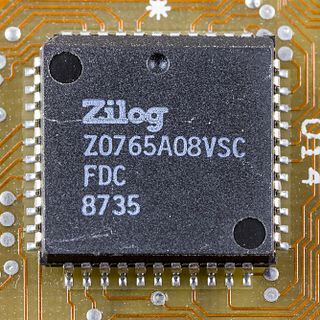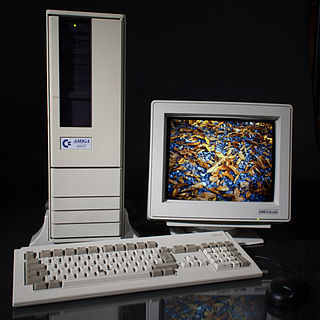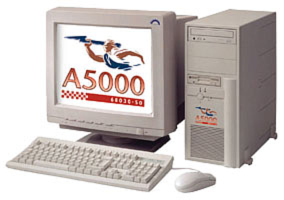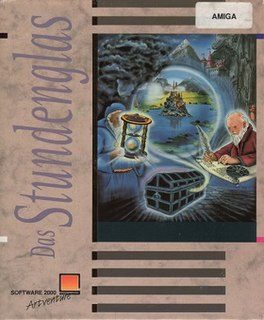
Amiga is a family of personal computers introduced by Commodore in 1985. The original model is one of a number of mid-1980s computers with 16- or 32-bit processors, 256 KB or more of RAM, mouse-based GUIs, and significantly improved graphics and audio compared to previous 8-bit systems. This includes the Atari ST—released earlier the same year—as well as the Macintosh and Acorn Archimedes. Based on the Motorola 68000 microprocessor, the Amiga differs from its contemporaries through the inclusion of custom hardware to accelerate graphics and sound, including sprites and a blitter, and a pre-emptive multitasking operating system called AmigaOS.

The Atari ST is a line of personal computers from Atari Corporation and the successor to the Atari 8-bit family. The initial model, the 520ST, saw limited release in April–June 1985 and was widely available in July. It was the first personal computer with a bitmapped color GUI, using a version of Digital Research's GEM from February 1985.

The Amiga 500, also known as the A500, is the first low-end version of the Amiga home computer. It contains the same Motorola 68000 as the Amiga 1000, as well as the same graphics and sound coprocessors, but is in a smaller case similar to that of the Commodore 128.

Ophthalmology is a surgical subspecialty within medicine that deals with the diagnosis and treatment of eye disorders. An ophthalmologist is a physician who undergoes subspecialty training in medical and surgical eye care. Following a medical degree, a doctor specialising in ophthalmology must pursue additional postgraduate residency training specific to that field. This may include a one-year integrated internship that involves more general medical training in other fields such as internal medicine or general surgery. Following residency, additional specialty training may be sought in a particular aspect of eye pathology. Ophthalmologists prescribe medications to treat eye diseases, implement laser therapy, and perform surgery when needed. Ophthalmologists provide both primary and specialty eye care - medical and surgical. Most ophthalmologists participate in academic research on eye diseases at some point in their training and many include research as part of their career. Ophthalmology has always been at the forefront of medical research with a long history of advancement and innovation in eye care.

The Amiga 2000, or A2000, is a personal computer released by Commodore in March 1987. It was introduced as a "big box" expandable variant of the Amiga 1000 but quickly redesigned to share most of its electronic components with the contemporary Amiga 500 for cost reduction. Expansion capabilities include two 3.5" drive bays and one 5.25" bay that could be used by a 5.25" floppy drive, a hard drive, or CD-ROM once they became available.
WHDLoad is a software package for the Amiga platform to make installation of software to a hard disk easier, for such things as demos or games. Allowing for better compatibility for Amiga software, which can sometimes have hardware incompatibilities making them hard to use in emulated environments due to the widely varying hardware specifications of the Amiga product line across its history. WHDLoad basically circumvents the operating system in the Amiga for greater compatibility and preserves the original program environment.

Monster Business is a 1991 vertically scrolling platform game developed by Eclipse Software Design and published by Ascon that was released for the Amiga and Atari ST.

A floppy-disk controller (FDC) is a special-purpose integrated circuit and associated disk controller circuitry that directs and controls reading from and writing to a computer's floppy disk drive (FDD). The FDC is responsible for reading data presented from the host computer and converting it to the drive's on-disk format using one of a number of encoding schemes, like FM encoding or MFM encoding, and reading those formats and returning it to its original binary values.
Amiga software is computer software engineered to run on the Amiga personal computer. Amiga software covers many applications, including productivity, digital art, games, commercial, freeware and hobbyist products. The market was active in the late 1980s and early 1990s but then dwindled. Most Amiga products were originally created directly for the Amiga computer, and were not ported from other platforms.
AmigaOS is the proprietary native operating system of the Amiga personal computer. Since its introduction with the launch of the Amiga 1000 in 1985, there have been four major versions and several minor revisions of the operating system.

The Amiga 4000T, also known as A4000T, is a tower version of Commodore's A4000 personal computer. Using the AGA chipset, it was originally released in small quantities in 1994 with a 25 MHz Motorola 68040 CPU, and re-released in greater numbers by Escom in 1995, after Commodore's demise, along with a new variant which featured a 50 MHz Motorola 68060 CPU. Despite the subsequent demise of Escom, production was continued by QuikPak in North America into at least 1997.

Total Recall is a 1990 platform game developed and published by Ocean Software that was released for the Commodore 64, Amiga, Amstrad CPC, ZX Spectrum, and Nintendo Entertainment System. Total Recall is based on the 1990 film of the same name.
Kickstart is the bootstrap firmware of the Amiga computers developed by Commodore International. Its purpose is to initialize the Amiga hardware and core components of AmigaOS and then attempt to boot from a bootable volume, such as a floppy disk. Most Amiga models were shipped with the Kickstart firmware stored on ROM chips.

The Power A5000 was a planned Amiga clone computer, announced by DCE and Power Computing. It was one of the first Amiga clone computers announced after Gateway purchased the Amiga in 1997.

The Cafu Engine is a game engine developed by Carsten Fuchs. It is portable across platforms and runs on Windows and Linux, with plans to be adapted to OS X. The engine's source code is freely available under the MIT Licence.
The floppy disk is a data storage and transfer medium that was ubiquitous from the mid-1970s well into the 2000s. Besides the 3½-inch and 5¼-inch formats used in IBM PC compatible systems, or the 8-inch format that preceded them, many proprietary floppy disk formats were developed, either using a different disk design or special layout and encoding methods for the data held on the disk.

Conqueror is a video game released as the follow-up to Zarch, using the same landscape engine. It is a third-person shooter with strategy elements in which the player controls a fleet of tanks. It was originally developed and released on the Acorn Archimedes by Superior Software in 1988 and ported to other home computers in 1990 by Rainbow Arts. The game was well received, particularly for its blend of strategy and arcade action.

Clive Barker's Nightbreed: The Interactive Movie is a 1990 arcade adventure video game developed by Impact Software and published by Ocean Software on Atari ST and DOS. It is based on Clive Barker's movie Nightbreed, which in turn is based on Barker's novella Cabal. It was originally supposed to be part of a trilogy, alongside Clive Barker's Nightbreed: The Action Game and an ultimately-unreleased RPG.

Das Stundenglas is a German text adventure game published in 1990 by Software 2000 and developed by Weltenschmiede, and released for Amiga, Atari ST and DOS. Das Stundenglas is part of a text adventure trilogy; it is succeeded by Die Kathedrale (1991) and Hexuma (1992). The trilogy lacks an overarching plot, and in each entry the setting, role of the protagonist, and goal differ between each game. Games in the trilogy do not require knowledge of the other entries and may be played as standalone games.

Cover Girl Strip Poker, alternately titled Cover Girl Poker, is a 1991 erotic video game based upon five-card strip poker and originally developed and self-published by Emotional Pictures; it was released for the Amiga, DOS, Commodore 64, CDTV, and CD32. Cover Girl Strip Poker is the original Danish title; it was retitled Cover Girl Poker outside of Denmark in the rest of Europe, and the title was subsequently reverted to Cover Girl Strip Poker for the European CDTV and CD-ROM DOS releases. Emotional Pictures was a subsidiary of Danish company InterActive Vision A/S.

















